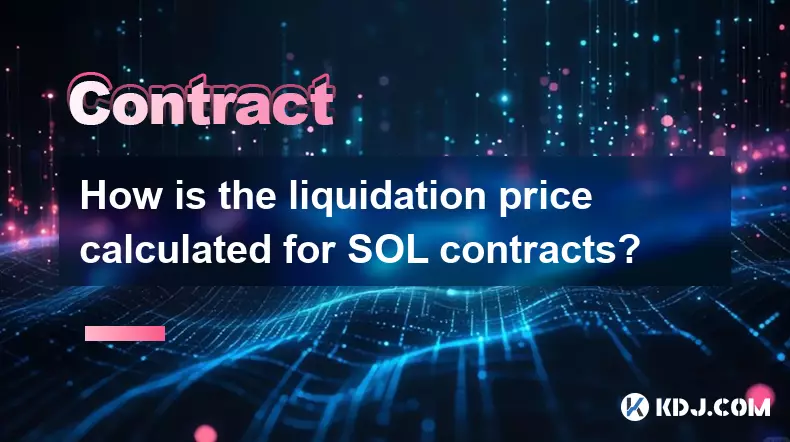-
 bitcoin
bitcoin $122090.672462 USD
1.59% -
 ethereum
ethereum $4493.758974 USD
0.56% -
 xrp
xrp $3.033145 USD
0.65% -
 tether
tether $1.000629 USD
0.00% -
 bnb
bnb $1169.854250 USD
7.07% -
 solana
solana $230.954786 USD
-0.19% -
 usd-coin
usd-coin $0.999785 USD
0.00% -
 dogecoin
dogecoin $0.256108 USD
-1.12% -
 tron
tron $0.342333 USD
-0.12% -
 cardano
cardano $0.859632 USD
-0.10% -
 hyperliquid
hyperliquid $48.932146 USD
-2.25% -
 chainlink
chainlink $22.345466 USD
-1.29% -
 ethena-usde
ethena-usde $1.000217 USD
-0.03% -
 avalanche
avalanche $31.203456 USD
1.93% -
 sui
sui $3.579145 USD
1.05%
How is the liquidation price calculated for SOL contracts?
The liquidation price in SOL contracts is triggered when margin falls below maintenance levels, influenced by leverage, fees, and funding rates.
Oct 04, 2025 at 12:36 am

Understanding Liquidation Price in SOL Contracts
1. The liquidation price for SOL contracts is determined by the point at which a trader’s margin balance falls below the required maintenance margin. This occurs when the market moves against an open leveraged position. For perpetual or futures contracts on Solana-based platforms, exchanges use a formula that considers entry price, leverage, fees, and funding rates.
2. When a user opens a long position in SOL, the liquidation price is typically lower than the entry price, especially under high leverage. Conversely, for short positions, the liquidation price sits above the entry level. As losses accumulate, the available margin decreases. Once it drops to the threshold defined by the exchange's risk engine, automatic liquidation is triggered.
3. Different decentralized and centralized exchanges may apply slight variations in their calculation models. Some platforms factor in insurance fund contributions or dynamic fee adjustments. However, the core principle remains consistent: liquidation happens when collateral no longer covers potential default risk.
Key Variables Affecting SOL Liquidation
1. Leverage ratio directly impacts how close the liquidation price is to the entry point. Higher leverage, such as 50x or 100x, brings the liquidation price dangerously near the current market value. Traders using 5x or 10x leverage enjoy more buffer against volatility.
2. Position size plays a crucial role. Larger positions require more margin, and any adverse movement has a magnified effect on equity. Smaller positions with proportional margin are less prone to sudden liquidation during minor price swings.
3. Funding payments in perpetual contracts can shift the effective cost basis over time. Positive funding for shorts or negative funding for longs may gradually push the position closer to liquidation, even without major price changes.
4. Trading fees, both opening and closing, are subtracted from the margin account. Though minimal per trade, they reduce the usable equity slightly, influencing the final liquidation threshold, particularly in high-frequency or high-leverage setups.
Risk Management Strategies for SOL Traders
1. Setting stop-loss orders manually helps avoid reaching the auto-liquidation point. These act as protective exits before the system forcibly closes the position, often at unfavorable prices due to slippage or auction mechanisms.
2. Monitoring wallet equity and maintaining extra margin beyond the minimum requirement reduces vulnerability to flash crashes or pump-and-dump schemes common in crypto markets. Keeping a healthy distance between current price and liquidation price provides breathing room during volatile periods.
3. Using lower leverage increases survival time during sideways or choppy markets. Even if the prediction is correct over time, excessive leverage can cause early exit due to short-term fluctuations in SOL’s price.
4. Selecting stable trading venues with transparent liquidation engines and fair price oracles ensures that liquidations occur based on real market data rather than manipulated feeds. Platforms integrated with Pyth Network or Switchboard offer reliable pricing for Solana derivatives.
Common Questions About SOL Contract Liquidation
How do exchanges determine the mark price for liquidation?Exchanges use a mark price derived from external price feeds and time-weighted averages to prevent manipulation. This differs from the last traded price and avoids unfair liquidations during sudden spikes or dips.
Can I get liquidated even if the market recovers immediately?Yes. Once the maintenance margin is breached, the system executes liquidation automatically. It does not anticipate future price reversals. The position is closed regardless of subsequent recovery.
What happens to my funds after liquidation?The remaining balance after settling the debt and fees is returned to your wallet. If the loss exceeds your margin, insurance funds cover the deficit, but you lose the entire initial margin in most cases.
Do partial liquidations exist on SOL derivative platforms?Some advanced platforms implement partial liquidation mechanisms, reducing position size incrementally to preserve part of the margin. However, many still enforce full liquidation upon breach of margin requirements.
Disclaimer:info@kdj.com
The information provided is not trading advice. kdj.com does not assume any responsibility for any investments made based on the information provided in this article. Cryptocurrencies are highly volatile and it is highly recommended that you invest with caution after thorough research!
If you believe that the content used on this website infringes your copyright, please contact us immediately (info@kdj.com) and we will delete it promptly.
- BlockDAG, DOGE, HYPE Sponsorship: Crypto Trends Shaping 2025
- 2025-10-01 00:25:13
- Deutsche Börse and Circle: A StableCoin Adoption Powerhouse in Europe
- 2025-10-01 00:25:13
- BlockDAG's Presale Buzz: Is It the Crypto to Watch in October 2025?
- 2025-10-01 00:30:13
- Bitcoin, Crypto, and IQ: When Genius Meets Digital Gold?
- 2025-10-01 00:30:13
- Stablecoins, American Innovation, and Wallet Tokens: The Next Frontier
- 2025-10-01 00:35:12
- NBU, Coins, and Crypto in Ukraine: A New Yorker's Take
- 2025-10-01 00:45:14
Related knowledge

What is the difference between futures and perpetual contracts for Bitcoin?
Oct 02,2025 at 11:54pm
Understanding Bitcoin Futures Contracts1. Bitcoin futures are derivative instruments that allow traders to speculate on the future price of Bitcoin at...

What is the best time to trade PEPE contracts?
Oct 03,2025 at 11:54am
Understanding PEPE Contract Volatility1. PEPE contracts exhibit extreme price fluctuations due to their meme-based nature and low market cap. Trading ...

What are the common mistakes to avoid with Bitcoincoin contracts?
Oct 03,2025 at 08:54am
Emerging Trends in the Cryptocurrency Market1. Decentralized finance (DeFi) platforms continue to expand their influence across the blockchain ecosyst...

What is the maintenance margin for Bitcoin contracts?
Oct 02,2025 at 01:36am
Decentralized Exchanges Gain Momentum in 20241. Decentralized exchanges (DEXs) have seen a significant rise in trading volume, surpassing centralized ...

How to use technical analysis for trading XRP contracts?
Oct 03,2025 at 01:18pm
Understanding Price Patterns in XRP Futures1. Identifying chart patterns such as triangles, head and shoulders, and double tops or bottoms can provide...

What does "longing" PEPE contracts mean?
Oct 03,2025 at 11:54pm
Understanding Decentralized Exchanges in the Crypto Ecosystem1. Decentralized exchanges (DEXs) operate without a central authority, allowing users to ...

What is the difference between futures and perpetual contracts for Bitcoin?
Oct 02,2025 at 11:54pm
Understanding Bitcoin Futures Contracts1. Bitcoin futures are derivative instruments that allow traders to speculate on the future price of Bitcoin at...

What is the best time to trade PEPE contracts?
Oct 03,2025 at 11:54am
Understanding PEPE Contract Volatility1. PEPE contracts exhibit extreme price fluctuations due to their meme-based nature and low market cap. Trading ...

What are the common mistakes to avoid with Bitcoincoin contracts?
Oct 03,2025 at 08:54am
Emerging Trends in the Cryptocurrency Market1. Decentralized finance (DeFi) platforms continue to expand their influence across the blockchain ecosyst...

What is the maintenance margin for Bitcoin contracts?
Oct 02,2025 at 01:36am
Decentralized Exchanges Gain Momentum in 20241. Decentralized exchanges (DEXs) have seen a significant rise in trading volume, surpassing centralized ...

How to use technical analysis for trading XRP contracts?
Oct 03,2025 at 01:18pm
Understanding Price Patterns in XRP Futures1. Identifying chart patterns such as triangles, head and shoulders, and double tops or bottoms can provide...

What does "longing" PEPE contracts mean?
Oct 03,2025 at 11:54pm
Understanding Decentralized Exchanges in the Crypto Ecosystem1. Decentralized exchanges (DEXs) operate without a central authority, allowing users to ...
See all articles










































































